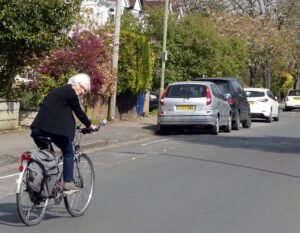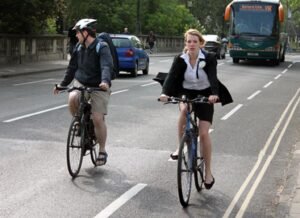The magic of a bicycle mirror
By Andy Chivers
Andy is a trustee of Cyclox
Cycling in traffic requires confidence, careful steering and full awareness of vehicles around you. All road users benefit from knowing what traffic is doing behind them. Cyclists benefit more than most, given the difference in size and speed compared to a car or lorry, and the need to move out to the centre line to pass a parked car or make a right turn.
Some years ago, Cycling UK ran a campaign called ‘The art of the backward look.’ It aimed to get people on bikes confident in looking behind them. The backward look is a skill not all cyclists have, which is why some people stop at the kerb to look behind them before turning right. And it’s why a mirror is such a good idea.
The backward look

Our ears help us know what’s behind us, but that is not enough. Turning to look behind you is something to practise away from busy traffic. Taking your right hand off the handlebar allows you to turn your whole upper body, but you can get a good look by turning your head down and right while keeping both hands on the handlebars. Try it next time you’re out on your bike. Clearly you need to keep riding in a straight line while you do this. An Oxfordshire study from 15 years ago showed that men were better than women at the backward look, but soberingly ‘more men crashed into parked cars’ while looking behind them. Sadly, more women than men were hit by overtaking cars.
If you make your backward look obvious, the car driver behind realises that you are making a manoeuvre and will usually slow down to let you move to the middle. That’s even more likely if you make eye contact – always a good thing on the roads. After looking back, seeing a gap, and making a firm clear hand signal you can then move over to the outside of your lane to turn right. It is wise not to get too close to the central white line: some drivers may try to squeeze past on the inside, and oncoming cars will be very close. You need to take up the same space as a car and allow a queue to form behind you until you can make your turn.
The backward look is a skill not all cyclists have, which is why a mirror is such a good idea.
What about a mirror?

A mirror is like having a continuous sneak preview of what is happening behind you. On open roads in the country, it gives you early warning of cars approaching from behind so you don’t get a surprise. Turning right, you can signal and make your move out into the middle of the lane at a moment when you are confident that you have plenty of space. It may mean you don’t need to look behind you, though doing so can be an extra security and as mentioned, it tells people behind that you are planning a move.
A common challenge for bicycle riders is going through ‘pinch points’ where pedestrian refuges – traffic islands for people crossing the road – narrow the carriageway so that there is not enough room for a car to overtake a bike safely. Some drivers may be tempted to try. The experienced cycle rider with a mirror sees when there is a gap in the traffic and moves out to the middle of the lane well in advance, so that car drivers have to wait until the cyclist is past the narrow section.
Bike mirrors don’t have the technical sophistication of car mirrors. But they are cheap, easy to fit, at least on straight handlebars, and can fold out of the way. Buy one today and get eyes in the back of your head!
